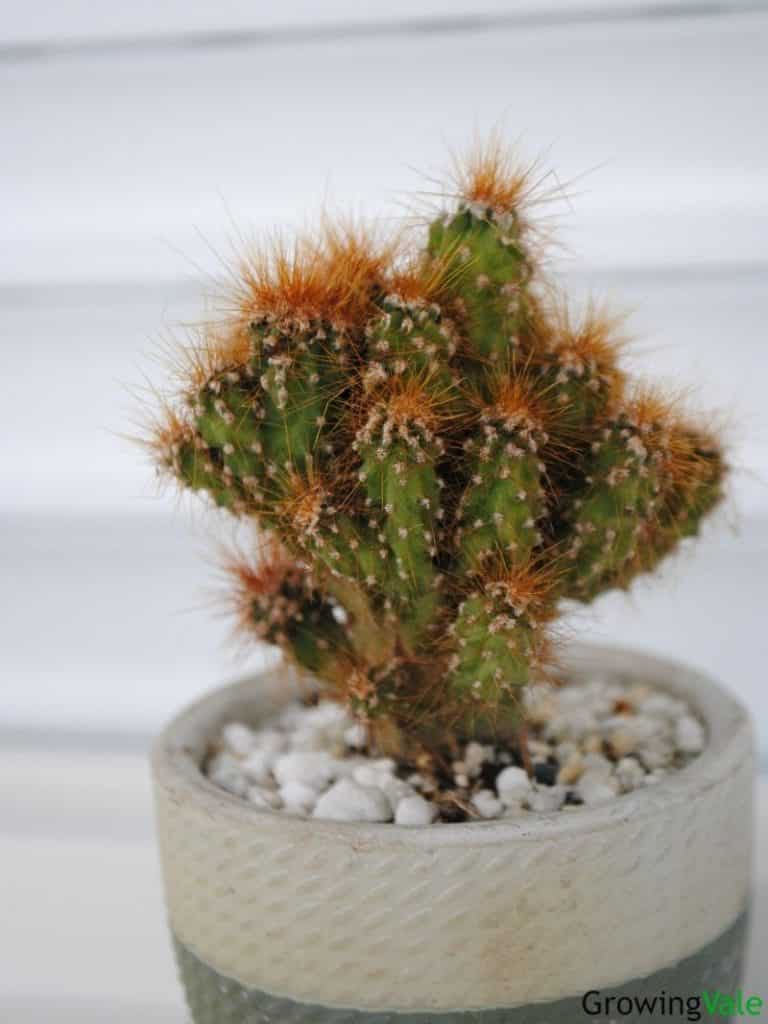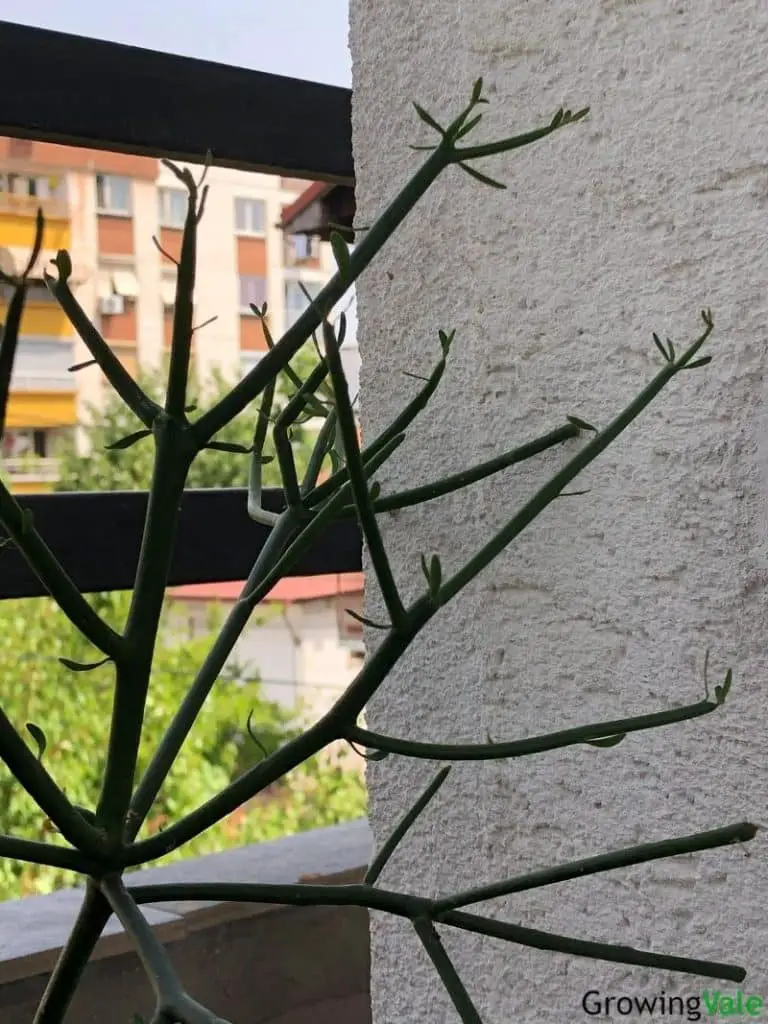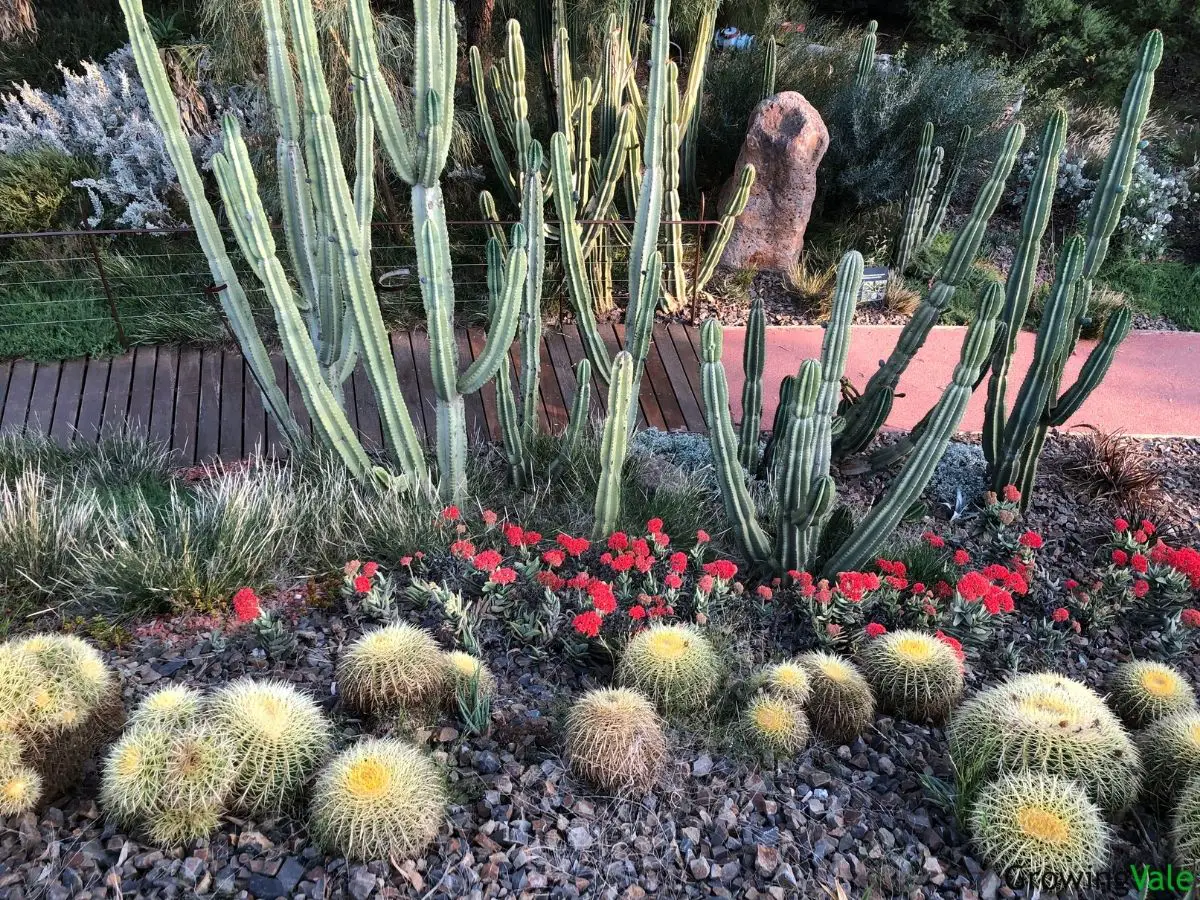Whether you want a couple of cacti to make an imposing statement in your desert garden or you want one for growing indoors to create a conservation piece, one of these large cactus plants is sure to fit the bill.
When grown indoors, many large cacti won’t reach their full potential because their top growth is restricted by the size of their root system. However, a normally tall-growing cactus can still get quite large when grown in a large-sized pot indoors.
When envisioning the end result, you might also want to remember that many cacti species are extremely slow-growing, so your particular species may take many years to reach the height that you want.
Here are 21 types of large-growing cacti that might interest you.
1 Aporocactus flagelliformis (Rat tail cactus)
The first cactus on our list is not a particularly tall-growing cactus, however, it can get quite big with thick hanging stems that can reach a length of 3.3 feet (1 m).
When planted in a large hanging basket, this cactus can make quite a statement. Don’t be fooled by the thick fuzzy-looking stems as these are actually covered with very fine reddish-yellow spines.
This plant really puts on a show when it flowers. Masses of magenta-colored flowers emerge along the stems and these can be up to 3 inches (7.5 cm) long.
2 Austrocylindropuntia subulata (Eves needle cactus)
This is a tree-like cactus that produces numerous upright, branched stems with multiple spines that can be up to 3 inches (7.5 cm) long. When grown outdoors, this plant can reach a height of around 13 feet (4 m).
Small cylindrical leaves grow on the long stems while red almost cup-shaped flowers appear on the ends of the stems. When the flowers have finished the plant produces red fruits.
3 Carnegiea gigantea (Saguaro cactus)
The Saguaro cactus dominates the landscape around arid regions in the US, particularly in the state of Arizona where it’s the State Wildflower. It’s a tall tree-like cactus with tall, columnar branched stems that reach up to the sky.
When grown outdoors, it can reach a massive height of around 65 feet (20 m). However, it’s extremely slow-growing and will only grow around 0.25 inches (0.6 cm) in height over two years. Branches only appear on the columnar stems once the plant has reached a height of around 16.5 feet (5 m). This could take around 50 to 70 years.
This makes it an ideal specimen for growing in a pot indoors as it will take many years to get to a large height. This also means that it won’t require repotting very often.
If you want to see this plant in bloom, you’re going to have to wait until it’s around 30 to 35 years old. For your patience, you’ll be rewarded with white flowers that can be up to 5 inches (12.5 cm) long.
4 Cephalocereus senilis (Old man cactus)
This lovely columnar cactus can grow to a height of around 50 feet (15m). The tall columnar stems are normally unbranched but they have numerous ribs that are covered with hair-like spines. This makes an excellent specimen to grow indoors in a large pot.
The flowers are pale pink and can be up to 2 inches (5 cm) long. After flowering, this large cactus plant produces pinkish-red fruits that have yellow hairy spines.
5 Cereus hildmannianus (Hedge cactus)
This is another tree-like cactus that has numerous branches that are blue-green in color. Once the plant matures, it can develop a woody trunk. This cactus can grow to a height of 50 feet (15 m). The individual branches can reach a diameter of 6 inches (15 cm) and have between four to six ribs.
On some plants, the branches can be spineless but on others, there can be numerous spines that are quite short and golden or brown in color. The flowers on this cactus are quite spectacular. They are yellowish-white in color and can reach a length of 12 inches (30 cm) and a diameter of 6 inches (15 cm). These flowers open at night and will remain open for the following day.
After flowering, this big cactus plant produces egg-shaped fruits that are edible. These are green in color, to begin with, and then change to pinkish-red as they mature.
6 Cereus repandus (Peruvian apple cactus)

This is another large tree-like cactus that has numerous columnar stems. These are generally heavily branched from the base.
As a tall cactus, the plant can grow to a height of around 33 feet (10 m). The lovely succulent stems are blue-gray in color and heavily ribbed. Some plants have spineless stems while others can be heavily spined.
The flowers on this cactus are nocturnal which means that they are only open at night. But, they are truly a magnificent sight to see. They have white petals that are tinged with red tips and can be up to 6 inches (15 cm) in diameter.
The fruits that appear after the flowers are edible and are locally known as Pitaya or Peruvian apples. They’re egg-shaped and usually red in color.
7 Echinocactus grusonii (Golden barrel cactus)
Although not a very tall grower, the golden barrel cactus makes up for in width. It usually reaches a height of around 3.3 feet (1 m) but can grow equally as wide. It’s a most attractive specimen with its round barrel-like shape and a covering of golden spines.
The flowers appear around the crown of the plant in summer. They are yellow in color and around 2 inches (5 cm) in diameter. It’s definitely one of the very eye-catching large cactus types.
8 Echinopsis pachanoi (San Pedro cactus)
This interesting species has tall columnar green stems with around six to eight ribs. It can reach a height of around 20 feet (3 m). Each stem can reach a diameter of around 6 inches (15 cm).
This is quite a fast-growing cactus and will branch at the base as it grows. Along each rib, there are white areoles that produce short yellow or brown spines. The flowers on this cactus are white and grow on the ends of the stems. These only open at night and can be around 9.6 inches (24 cm) long and 8 inches (20 cm) in diameter.
9 Euphorbia ingens (Candelabra cactus)
This large tree cactus forms a short trunk with tall upright branches that are dark green in color. These branches form a rounded crown giving this specimen an unusual balloon-like shape. It can grow to a height of 40 feet (12 m).
Each fleshy green branch has around four or five ridges with small spines. During the fall and into the winter, this cactus produces greenish-yellow flowers on the tips of the branches. After flowering, the fruits are red to purple and are 3-lobed.
10 Euphorbia tirucalli (Pencil cactus)

This cacti species forms a small tree that can reach a height of around 16.5 feet (5 m). Some specimens have even been known to reach a height of 33 feet (10 m). The stems are cylindrical and quite thin, only around 0.3 inches (0.8 cm) in diameter. New stems will produce long leaves but these will soon drop off.
The flowers on this plant are quite inconspicuous and yellow in color. However, they appear in clusters in the apex of the stems or sometimes, in the angles of the branches.
11 Euphorbia trigona (African milk tree)
This cactus has an interesting architectural shape that makes it suitable for use in indoor decor. It can reach a height of around 6 to 8 feet 2+ m). It’s also quite a fast grower. The stems are thick, green, and three-sided, hence the botanical name “trigona”.
Each rib has numerous reddish-brown spines that are arranged in pairs of two. In addition, long leaves will grow between the spines on each rib. This plant has never been known to produce flowers and experts believe that it may be a natural hybrid.
12 Ferocactus pilosus (Mexican lime cactus)
This is an attractive cactus species that can grow to a height of around 8 feet (240 cm) and a diameter of around 18 inches (45 cm). It’s a simple columnar plant but can produce large clumps with barrel-shaped stems. Each stem has around 20 ribs that are adorned with bright red central spines and white radial spines. This gives the plant a reddish glow.
The small yellow or red flowers grow on the top of the crown. Once flowering has finished, the plant produces yellow fruits that are up to 1.6 inches (4cm) long.
13 Myrtillocactus geometrizans (Blue candle cactus)
This is a large cactus that is heavily branches with blue-gray stems. It can grow to a height of 14.8 feet (4.5 m). The stems have five or six ribs that sport areoles with three to five spines.
The flowers are quite small and greenish-white in color. The fruits are edible, oblong, and dark red in color. These are only around 0.8 inches (2 cm) in diameter.
14 Oreocereus celsianus (Old man of the Andes)
This cylindrical cactus is covered with fine white hairs all over. This gives it a fuzzy appearance. It also has orange-yellow spines that grow from the areoles in the ribs. It can grow to a height of around 10 feet (3 m) and a diameter of around 24 inches (61 cm).
15 Opuntia stricta (Erect prickly pear cactus)
This Opuntia can grow to a height of 6.6 feet (2 m) but can spread quite widely too. The fleshy gray-green stem sections are often referred to as pads.
Each one can be around 14 inches (35 cm) long and around 8 inches (20 cm) wide. The areoles are spread over the surface of the pads and often have yellowish spines that are around 1.6 inches (4 cm) long.
The yellow flowers appear in spring and summer around the edges of the pads. The egg-shaped fruits are edible and purplish-red in color. If grown outdoors, this can be quite an invasive species because the pads will drop off and propagate readily when they touch the soil.
In some countries, such as Australia, this plant is considered a noxious weed. However, if you grow one indoors in a large pot, it’s easier to control its growth.
16 Pachycereus marginatus (Mexican fence post cactus)
This imposing cactus can make quite a statement when grown indoors in a large pot. It features columnar stems that can reach a height of around 12 feet (3.7 m). These stems have around five to seven ribs with short, sharp spines along the ridges.
The flowers are normally pink but can sometimes be green. These are followed by spiny fruits that are red or yellow and contain numerous black seeds.
17 Pachycereus pringlei (Mexican giant cardon cactus)
This is the tallest cactus species in the entire world. It has been recorded as growing to a maximum height of 63 feet (19.2 m). The plant produces several erect stems that are ribbed and very similar in appearance to the Saguaro cactus.
The flowers are white in color and grow along the ribs of the stems. However, they only open at night.
18 Pachycereus schottii (Totem pole cactus)
This is a slow-growing cactus that forms numerous upright, columnar stems from the base. This plant can reach a height of 13.1 feet (4m) with each stem reaching a diameter of around 6.4 inches (16 cm).
The tips of each mature stem are covered with long bristles that are strongly twisted. In contrast, young plants only have a few short spines at the tips of the stems.
The flowers of these big cactus plants are nocturnal and greenish-white in color. They also have a little pink on the inside. These are followed by edible fruits that are red in color.
19 Parodia leninghausii (Golden ball cactus)
Although it’s not one of the largest cacti on our list, this species is definitely one of the more attractive ones. The stems are columnar and can reach a height of around 3.3 feet (1 m) and a diameter of around 5 inches (12 cm).
Each stem is covered with lovely, soft golden spines that are not sharp. This plant really shines when it’s in flower. It produces masses of large yellow blooms at its crown. These flowers can be up to 2 inches (5 cm) in diameter.
20 Pilosocereus pachycladus (Blue columnar cactus)
This is quite a spectacular columnar cactus with its bluish-gray erect stems that can reach a height of 33 feet (10 m). Over time, the plant produces a distinct trunk at the base with the stems forming a balloon-type canopy.
The stems are heavily ribbed with areoles and short sharp spines along the ridges. The spines have a golden color but turn gray over time. The flowers are white and tubular. They have yellow centers and the tips of the petals are tinged with red. These grow along the ridges of the stems.
21 Stenocereus thurberi (Organ pipe cactus)
This columnar cactus produces several narrow upright stems from a very short trunk that is hardly visible above ground. Each stem can reach a height of 16 feet (4.9 m) and a diameter of 6 inches (15 cm). Each individual plant can reach a diameter of up to 12 feet (3.7 m).
There are around 12 to 19 ribs on each stem and these have black or dark brown spines on the ridges. Older plants can produce flowers annually but it can take around 150 years for a plant to reach maturity.
Flowers are generally white but they can have a pink or purple tint. They only open at night and will close up again once morning arrives. Following the flowers, fruits will grow that are about the size of a tennis ball.
Check our guide on cactus propagation and growing cactus plants if you’re interested in adding a few more to your succulents collection.
See more: Tiny cactus plants

